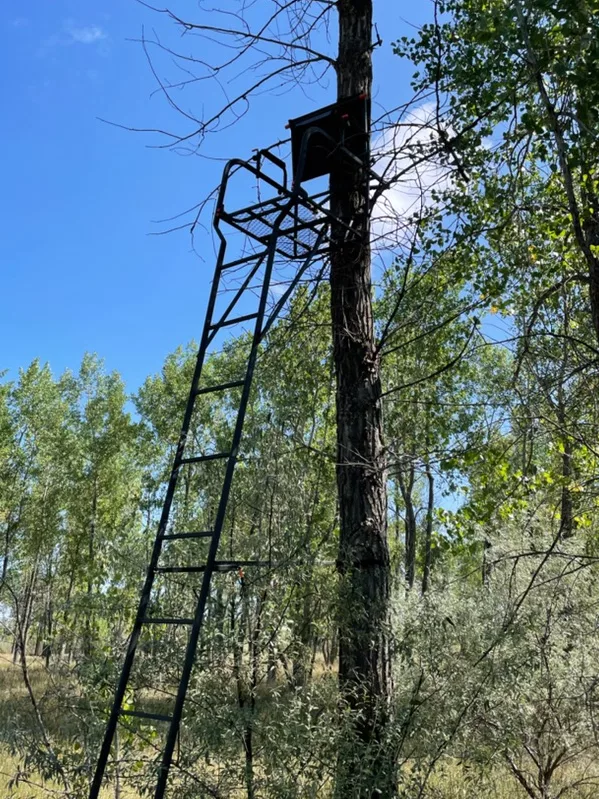
August provides some welcome downtime and a transition period from fishing to hunting. With deer archery seasons in some areas just days away, the final preparations (or perhaps the scramble) in assessing tree stand location for both the
upcoming bow and later firearms seasons are underway. But beyond the process of assembling stands and hanging them or heading out to the site of a semi-permanent perch used year-after-year, inspecting those deer stands for safety is something that should not be overlooked in the excitement of the preparatory process.
While my review this summer of the two stand sites I use revealed little more than a couple clicks to tighten the ratchet straps holding them in place, I recalled with a laugh during this year’s efforts of the time I ventured out one August and found a two-foot hole in the sandy ground beneath the legs of a favorite model, and the connector bolts and the holes between the seat and the base charred black, with some of the metal completely melted. After a few quick seconds of detective work, I realized that lightning had struck the metal stand in a summer storm in the weeks between hanging trail
cameras and the stand site review. I immediately took the stand down and scrapped it and was required to purchase a new one.
Inspect and Install
For new stands, assembly is the first point in determining their structural integrity. The first stand I ever bought came out of the box missing a bar leading up from the ladder to the arm rest; a vital part of the structure that didn’t allow me to finish it. The first lesson in stand safety, is to make sure you have all the parts and they’re put together correctly and firmly. Secondly, once assembled per the instructions, installation can provide a big challenge when done alone. That’s why it’s best to have at least one other person assist in the placement, attachment and testing of the stand once it has found its place against a tree. Managing the process alone can be a source of injury, if not just fatigue in the heat and humidity this time of year. Take the time to ensure the stand is put together right and enlist some extra help to guarantee a safe installation before the season even starts, bringing along a ladder to help in the efforts for safest placement.
Review and Repair (or Remove)
A lot has happened since the final days of deer season last year. Snow, melt, rain, wind, shifts in ground moisture, and notably, animal activity, can all impact those stands that are left out in the field from season to season. When checking out stands that have been exposed to those elements – even permanent ones, or larger elevated blinds – key in on those areas that are likely most influenced by those factors. Straps securing the stand to a tree are an obvious weak point. Be certain squirrels, insects or other critters haven’t chewed on the fabric of the strap, and double check to make certain the ratchet portion is still functional and can tighten any looseness caused by rain, wind, or the stretching of the material over time.
Inspect the base as well. Beyond the oddball lightning strike, ground-dwelling animals such as badgers and other burrowing critters can shift the soil below. I’ve even heard stories of beavers biting into the wooden legs of an elevated blind unit, requiring replacement. Make sure those structures that connect the stand to the ground and allow for safe climbing are securely planted in the soil and no shifting has occurred.
Strap for Safety
Finally, the most underutilized safety tools when it comes to stand safety are the
harness strap for preventing falls and a lanyard for hauling up bows, firearms and gear.
While inspecting stands this time of year, install a safety cord that is connected to the
tree with a strap which is in good condition, and if utilized, a carabiner that can more
than support a hunter’s weight, such as a 300- or 500-pound-test model. Wear a safety
harness into the field and ascend the stand and test it out, twisting, turning and
pretending to draw a bow to ensure good fit, comfort and a safe standing shot while
wearing the harness connected to the tree with the safety cord and strap.
The four-dollar investment in a haul lanyard ensures both hands are free for climbing a
ladder stand or getting up into an elevated blind. If necessary, replace smaller clips with
larger carabiners to better hook onto gear packs, bows and guns during the season,
and adjust the length of the lanyard so that the clip in point is elevated and your
equipment does not touch the ground, especially the nocks of arrows or the cams of the
bow, to prevent inconvenient accumulation of dirt, or potential damage. Remember to
haul up all firearms in an unloaded state when the season comes.
Through careful assembly and installation of new stands, a thorough examination of
those permanent and semi-permanent perches that remain in the field year-to-year, and
the placement of necessary safety straps and gear lanyards, a safe autumn of hunting
can be assured this season…in our outdoors.
By Nick Simonson
